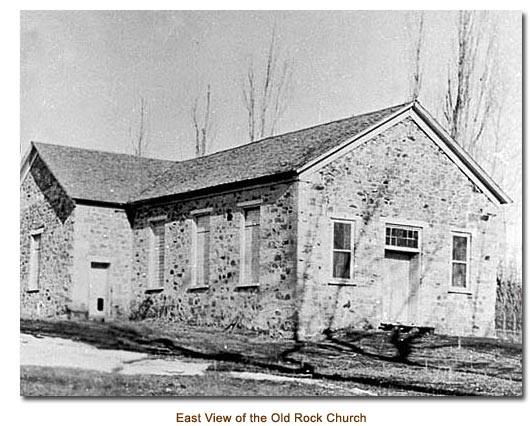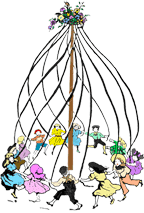Mendon, Utah
Mendon, an old Cache Valley town located about nine miles west of Logan, was organized as a ward in November of 1859. During 1860 its population doubled and by 1870 it was larger than it is today. Old Mendon was an interesting place. Cosmopolitan in make-up, its friendly citizens were Welch, Irish, German, (one French-Italian), Scotch, English and straight American. Up until the later Nineties a youngster could hear delicious Scotch, Musical Welch, broken Scandinavian, broad English, a bit of Irish or German, as well as regular American, in the spoken work at church or in the homes. The present Mendon has lost all of the color of the old period, as have most of the other Cache Valley towns.
Through the sixties most of the young men of Mendon made the long trip to Florence with ox teams to bring emigrants out to Utah. Returning to their hometowns these same young men married, built rock houses and began to work their lands. By the end of the seventies, however, the old town was becoming crowded. No more water for irrigation was available, and adventurous spirits yearned for larger opportunities and new pastures. By the mid-eighties the old hive swarmed and about a third of the Mendon citizens founded the town of Teton in the Snake River country. When dry farming came into prominence toward the end of the nineties, there was another migration. Between 1900 and 1910 a large percentage of the younger men of Mendon homesteaded land in Holbrook and the Arbon Valley. The present migration is one of college trained young men and women who accept posts in various parts of the country.
In the balmy days of old Mendon the dominant interest; aside from providing family necessities, was in raising fine horses. The town had a racetrack and matched its speedsters against the best horseflesh Moses and G. W. Thatcher and other horse breeders of Logan could bring. The old Utah Northern Railroad ran special trains from Logan to the racetrack. Such events put verve and zest into the spirit of the people and intensified their living.
Mendon was lucky since, because of its location, the first railroad dropped down into it from Collinston Hill and then went directly east to Logan. Mendon was the shipping point for the West Side south of Cache Junction and long trains of wagons loaded with wheat came from Wellsville and other places. The church had a large storehouse at the station and a clerk to tend to business.
To Mendonites the social life of old days evokes the choicest memories. All of us who lived there in the eighties and nineties have a nostalgic feeling for that Arcadian period. The whole town was hospitable and we were welcome to a meal in anybody’s house. Every good mother was an aunt to us. We knew everybody’s horse’s cows, dogs, vehicles, family history and every room in every old stone house. There was not much money in circulation, but there was an abundance of radiant health, friendship, good humor and fun. Old and young danced together in the meetinghouse. We often saw Bishop Henry Hughes feet twinkle in a step dance, after which Uncle Jim Hill would cut a pigeon wing. Father Kidman would do a “Jim Crow,” and a lady would dance the Highland Fling. Bobsleigh teams with merry-bells flashed along the streets and “shined” at corners all through the winter. Coasting and skating parties were frequent, as were oyster stews and “sociables.” Boys and girls played and sang and danced and ate. Memories of banquets served to threshers and headers are keenest of all. No people at any time ever had better things to eat than we old Mendonites had.
In athletics the town was up to date. Jumpers, runners, boxers, practiced hard and gave exhibitions on the public square. The old swimming hole trained fancy divers and strong swimmers. The baseball club was so good as to win occasionally from the Wellsville Maugham’s.
The old schools, in which one teacher taught all grades but the primary one, were taken seriously. Students of ages up to thirty attended when a famous teacher happened to be employed. The wood-burning stove in the middle of the room toasted unfortunates too near it, while those afar off were chilly. The liberty pole in the square separated North and South and many a jolly snowball battle between the opposing forces took place. Spelling bees and recitations were regular fare.
Music was featured in old Mendon. The ward choir was excellent. Girls’ choruses, duets, solos, quartets, and mixed quartets delighted us often. Sweeten’s Brass Band was known far and wide. Harmonica bands, mandolin and guitar clubs and groups of serenader’s put romance into summer nights.
The old town was also fortunate in its supply of dramatic readers. Four of the Whitney’s, Aunt Becky Hardman, Elizabeth Stumpf, Joseph T. Wood and others could hold us spellbound with their interpretations of dramatic episodes. Naturally, they put on plays such as East Lynne, The Lady of Lyons, Ben Bolt, The Lost Ship and Shore Acres. In summary, the closely-knit community provided for itself a well-rounded program for better living, which lasted until the modern transportation arrived.
There is much to say for those old days when we worked with our pioneer fathers and mothers who had character, faith and humanity and lived completely the lives they fashioned for themselves. It is impossible to relive such days, but recollections of them throw happy visions around us still.
*The old Mendon meetinghouse has long been a Cache Valley landmark. For 51 years, 1864 to 1915, it served as a religious and recreational center. Now, thought abandoned, it is preserved as a museum.